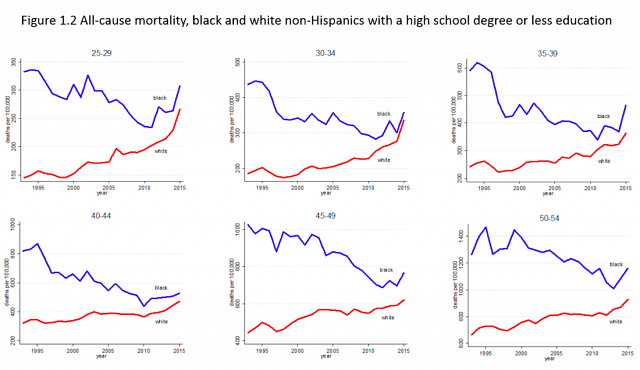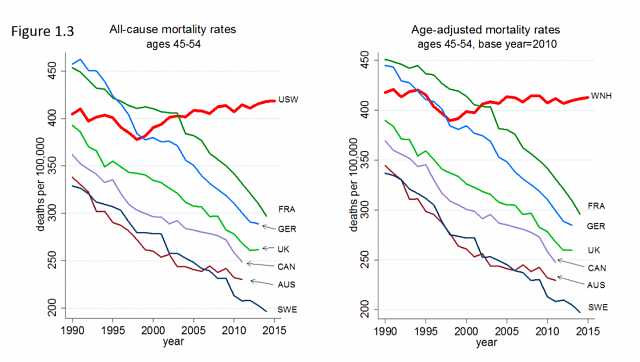Highlights
In late 2015, Princeton’s Anne Case and Angus Deaton released a blockbuster paper revealing that mortality rates for middle-aged, non-Hispanic white Americans were going up, particularly for those with less education. They were not the first to notice that something had gone awry with this demographic, but their paper landed amidst a national conversation about an opioid epidemic that was, and is still, spiraling out of control.
Now they have followed up with a more detailed analysis of mortality trends and proposed an explanation for them. In their narrative, the trend is driven by the “cumulative disadvantage” that lesser-educated whites face. Each birth cohort in this group experiences a worse labor market than the last one, and family structures and health are deteriorating for non-college whites as well. Importantly, because these disadvantages accumulate over the lifecycle, today’s middle-aged, non-college whites are likely to continue to have increased mortality rates into old age.
It’s important to start with a clear picture of what’s actually going on with whites’ mortality. Unfortunately, Case and Deaton worded a crucial part of their report rather crudely, giving the impression to casual readers that there has been a “crossover” between white and black mortality. That is false. A crossover exists only if one takes whites with no more than a high-school degree and compares them with all blacks regardless of education. This comparison is not apples-to-apples and frankly does not illustrate anything of importance.
There are two basic comparisons in the report, however, that are worth taking very seriously. Here is a set of charts that include only white and black Americans with no more than a high-school degree:

Source: Case & Deaton, “Mortality and Morbidity in the 21st Century,” Brookings Paper on Economic Activity, March 17, 2017.
Within each age group, white mortality has risen while black mortality has fallen or at least held steady. Blacks are still dying more than whites in these groups, but the gaps have narrowed markedly; for the 30-34 group, the gap is all but closed. It’s not that a racial mortality gap is a good thing, of course—but most would prefer to close such gaps solely by reducing mortality in the disadvantaged group, not by killing off the advantaged one too.
And here’s a striking cross-country comparison, an updated version of a chart in Case and Deaton’s previous paper:

Source: Case & Deaton, “Mortality and Morbidity in the 21st Century,” Brookings Paper on Economic Activity, March 17, 2017.
Obviously, something is happening to whites in the U.S. that is not happening in the lands of their ancestors, or in other Anglosphere nations like Canada and Australia.
Some other key pieces of the puzzle that are evident in Case and Deaton’s paper:
- The mortality increase is concentrated among those with a high-school degree or less. In fact, mortality is still decreasing for men and women with a four-year degree or more.1
- In terms of gender, the mortality increase is actually somewhat concentrated among women, not men.
- The trends vary by region as well. The East South Central Census division (Alabama, Kentucky, Tennessee, Mississippi) was especially hard hit.
- The mortality increase isn’t strictly limited to rural areas, but it isn’t happening in big cities or their suburbs.2
(See also an enormous collection of charts prepared by the statisticians Andrew Gelman and Jonathan Auerbach.)
Case and Deaton don’t purport to solve the entire riddle with this paper, but they do offer a rudimentary sketch of a theory. The authors pooh-pooh the popular notion that this is a simple function of income stagnation. Some of the basic income and mortality trends do seem to match for American whites—but blacks and Hispanics experienced the same income trends without seeing their mortality increase, and some European countries have had stagnant or declining incomes since the Great Recession without any interruption in their mortality declines.
The trick, the authors argue, is not to focus on what’s happening in people’s lives (or the broader economy) at a given moment. Instead, what really matters is cumulative disadvantage. The process begins as an individual grows up and enters the labor market, and advantages and disadvantages compound from there.
Lesser-educated whites have seen their support systems and their hopes for the future fall apart, and not just in terms of income. Kids today are less likely to out-earn their parents than they were in previous generations, a trend more pronounced for less-educated whites. This is in part because high-paying manufacturing jobs are no longer a given for those with strong backs but mediocre academic records, which also has the effect of making low-skilled men less marriageable—and thus the lesser-educated have increasingly stayed unmarried and had children out of wedlock. Unstable households are bad for kids, and importantly, single white American parents tend to “re-partner” more often than their African-American, Hispanic, and European peers. Meanwhile, the church has waned as a source of community support, again more for whites than for blacks. (Unsurprisingly, the roles of family structure and religion were rarely mentioned in the mainstream media's coverage of the report.)
That’s why a birth cohort that starts out with a higher mortality rate tends to continue having one as it ages, and why each cohort of lower-educated whites has had it worse than the last, as depicted here (though see Footnote 1 for a caution against looking at a single educational category over such a long period of time):

Source: Case & Deaton, “Mortality and Morbidity in the 21st Century,” Brookings Paper on Economic Activity, March 17, 2017.
This story does require placing some importance on speculative distinctions and theories. Blacks have much higher out-of-wedlock birth rates than whites, and the white and black trend lines for this statistic are quite similar, for example, but Case and Deaton would have us believe that repartnering is what’s really important. They also suggest that blacks may be less dismayed by income stagnation because they have been treated worse historically and have come to expect less, and may have more protective kin networks.
Case and Deaton themselves call their narrative “preliminary but plausible,” and readers would be well-advised to keep the authors’ own tentativeness in mind. They have given us a solid first step toward explaining a shocking trend of rising mortality in a First World country, but there are many steps we have yet to take.
Robert VerBruggen is managing editor of The American Conservative.
1. One concern about using the same educational categories to analyze data over time, though, is that the composition of each category shifts as Americans get more education. To use a particularly dramatic example, only a quarter of the adult population had a high-school degree in 1940, but today it’s mark of serious disadvantage to lack one. Case and Deaton divide their data into three educational categories—high school or less, some college, a BA or more—and claim that these categories have been stable since the early 1990s for non-Hispanic whites age 45-54, but Census data suggest there has been a modest shift toward the more educated groups over that time frame, especially between 1990 and 2000.
2. More specifically, in counties classified as “large central metro” or “large fringe metro,” both of which require the overall metro area to contain at least a million people.












